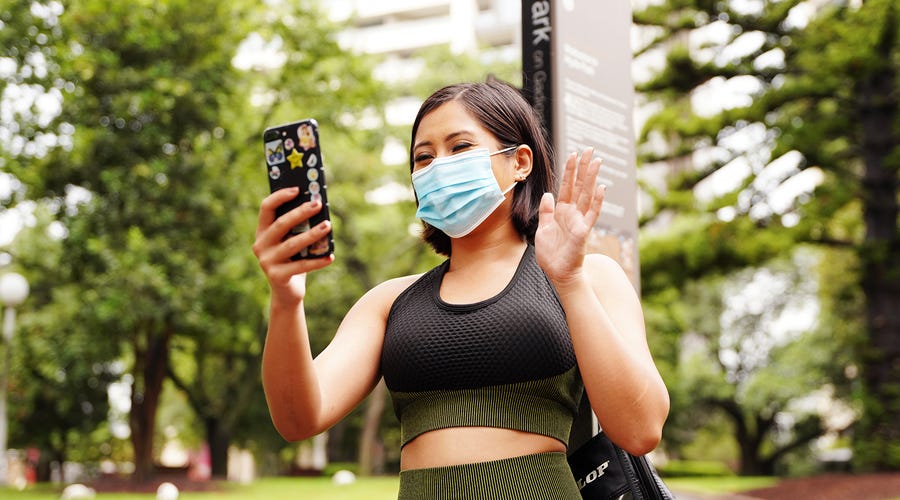
How to say farewell & goodbye in Japanese in 35 authentic ways
Author: Mayumi Hikida
You know the word, ‘sayonara’? Yes, it means ‘goodbye’ — but chances are, you wouldn't hear it in everyday conversation in Japan.
Just like 'こんにちは' (konnichiwa), 'さよなら' (sayonara) is one of the widely-known Japanese greetings that native speakers rarely use. If this fact surprises you, I'm glad you're here! If it doesn't, I'm also glad you've got here! We're going to explore the common phrases plus the in-depth Japanese goodbye culture in this post.
Table of contents
- What does ‘sayonara’ sound like to native speakers?
- How to say goodbye in Japanese
- Body language for goodbye
- Japanese goodbye songs
- Farewell in Japanese
What does ‘sayonara’ sound like to native speakers?
'さよなら' (sayonara), and its original form 'さようなら' (sayōnara, with an elongated 'o' sound), have the connotation that it's probably going to be a long or potentially forever farewell. For this reason, songs with 'さよなら' in the lyrics are often about breakups. Or some songs go like, "I'm not going to say sayonara because we'll see each other again!"
The word 'さようなら' (sayōnara) is derived from '左様ならば' (sayōnaraba). It's an old way to say 'then' — as in, "Well then, I'm heading off." Both 'さよなら' and 'さようなら' have gained formality and weight over time and dropped out of the everyday vocabulary.
Having said that, at my kindergarten, we mini people would say this together at the end of the day; "Sensei, sayōnara. Minasan, sayōnara." (Teacher, goodbye. Everyone, goodbye.) But we never said "Sayōnara!" or "Sayonara!" to our pals. We knew this word was only for rituals or songs.
When was the last time I greeted someone with 'sayonara'? Or heard someone say that to me? I tried to recall for longer than a few minutes, then gave up and had a slice of banana bread.
What do the Japanese say instead, then?

How to say goodbye in Japanese
The expressions listed below are 'fail-safe' — on condition that they're said in appropriate contexts. Some of them don't have English equivalents and require explanation, either. Read the notes carefully, and you'll be good!
The basics
Rightio. Let’s see how to say bye in Japanese other than 'sayonara'.
| English | Hiragana | Kanji + Hiragana OR Katakana | Romaji | Note |
| Bye. | じゃあね。 | (Only written in hiragana) | Jāne. | Casual |
| じゃあ。 | (Only written in hiragana) | Jā. | Casual | |
| Bye-bye. | ばいばい。 | バイバイ。 | Baibai. | Casual Often written in katakana. |
| Stay well. | げんきでね。 | 元気でね。 | Genki de ne. (Casual) | Commonly used when you don’t expect to see the person for a long while. |
| おげんきで。 | お元気で。 | Ogenki de. (Polite) | As above | |
| I am going to excuse myself. | では、しつれいします。 | では、失礼します。 | Dewa, shitsurei shimasu. | Polite |
| Thank you for having me. | おじゃましました。 | お邪魔しました。 | Ojama shimashita. | Polite The literal meaning is 'Sorry for bothering you.' Use it when you leave someone’s place. |
| Farewell. | ごきげんよう。 | (Only written in hiragana) | Gokigen’yō. | Very formal |
| Have a good [day, trip, etc.] | いってらっしゃい。 | 行ってらっしゃい。 | Itterasshai. (Casual) | When you see someone off leaving for school, work, or a trip. |
| いってらっしゃいませ。 | 行ってらっしゃいませ。 | Itterasshaimase. (Polite) | As above | |
| Take care. | おきをつけて。 | お気をつけて。 | Oki o tsukete. | Polite |
| Take care of yourself. | おからだにきをつけて。 | お体に気をつけて。 | Okarada ni ki o tsukete. | Polite ‘Okarada’ means ‘your body’. |
| Good night. | おやすみなさい。 | (Normally written only in hiragana) | Oyasuminasai. | Casual and polite |
'じゃあ' (jā) and 'では' (dewa) are both conjunctions meaning something like 'well then'. They alone can be used as 'bye' and often come before other phrases as well.
じゃあ: for friends, peers, or people on a first-name basis.
では: for people older than you or with higher status.
Also,
それでは (soredewa): for highly formal occasions. (This is the original form of 'では'.)
See you!
Not everyone is a big fan of goodbyes. Instead, they say...

| English | Hiragana | Kanji + Hiragana OR Katakana | Romaji | Note |
| See you. | またね。 | (Only written in hiragana) | Mata ne. | Casual |
| See you then. | じゃあ、また。 | (Only written in hiragana) | Jā, mata. | Casual |
| では、また。 | (Only written in hiragana) | Dewa, mata. | Polite | |
| See you tomorrow. | またあした。 | また明日。 | Mata ashita. | Casual |
| I’ll see you tomorrow. | またあしたおあいしましょう。 | また明日お会いしましょう。 | Mata ashita oaishimashō. | Polite |
| I will see you tomorrow. | またあすおめにかかります。 | また明日お目にかかります。 | Mata asu ome ni kakarimasu. | Formal ‘明日’ is pronounced as ‘あす’ (asu) on highly formal occasions. |
| See you next week. | またらいしゅう。 | また来週。 | Mata raishū. | Casual |
| I’ll see you next week. | またらいしゅうおあいしましょう。 | また来週お会いしましょう。 | Mata raishū oaishimashō. | Polite |
| I will see you next week. | またらいしゅうおめにかかります。 | また来週お目にかかります。 | Mata raishū ome ni kakarimasu. | Formal |
| See you next time. | またこんど。 | また今度。 | Mata kondo. | Casual |
| I’ll see you next time. | またこんどおあいしましょう。 | また今度お会いしましょう。 | Mata kondo oaishimashō. | Polite |
| I will see you next occasion. | またつぎのきかいにおめにかかります。 | また次の機会にお目にかかります。 | Mata tsugi no kikai ni ome ni kakarimasu. | Formal |
| I’ll email/call/message you again. | またメール / でんわ / めっせーじするね。 | またメール / 電話 / メッセージするね。 | Mata mēru/denwa/messēji suru ne. | Casual |
| またメール / でんわ / めっせーじします。 | またメール / 電話 / メッセージします。 | Mata mēru/denwa/messēji shimasu. | Polite |
In the business setting
To your boss, senior/junior colleagues, peers, clients, or customers. Below are some commonly used goodbyes in Business Japanese.

| English | Hiragana | Kanji + Hiragana OR Katakana | Romaji | Note |
| Thank you for your hard work. | おつかれさまでした。 | お疲れさまでした。 | Otsukaresama deshita. | Explained below. |
| Good work! | おつかれ! | お疲れ! | Otsukare! | Shortened and very casual ‘Otsukaresama deshita’. |
| Excuse me for leaving before you. | おさきにしつれいします。 | お先に失礼します。 | Osaki ni shitsurei shimasu. | Polite |
| おさきにしつれいいたします。 | お先に失礼いたします。 | Osaki ni shitsurei itashimasu. | Formal | |
| I’ll excuse myself, then. | それでは、しつれいします。 | それでは、失礼します。 | Soredewa, shitsurei shimasu. | Polite |
| I’m leaving (before you)! | おさきに! | お先に! | Osaki ni! | Shortened and very casual ‘Osaki ni shitsurei shimasu’. |
| I would appreciate it if you work with me nicely tomorrow, too. | あしたもよろしくおねがいします。 | 明日もよろしくお願いします。 | Ashita mo yoroshiku onegai shimasu. | Also explained below. |
| I would appreciate it if you work with me nicely again. | またよろしくおねがいします。 | またよろしくお願いします。 | Mata yoroshiku onegai shimasu. | As above |
'お疲れさまでした' (Otsukaresama deshita) is the most common 'goodbye' in the business environment. '疲れ' (tsukare) means 'tiredness' or 'fatigue', and this phrase expresses appreciation for hard work. ("You must be tired after making all the effort.") Sounds pretty appropriate for Japanese busy bees, though I think it's over the top that some teenagers say 'お疲れ様でした' to their senior kids. (THEY SERIOUSLY DO.)
What may confuse you is that people also say 'お疲れさまです' (Otsukaresama desu), 'お疲れさま' (Otsukaresama), or 'お疲れ' (Otsukare) as 'Hello'. You may hear it first in the morning. You may not be tired at all. Neither of you may not be leaving. They're such versatile phrases.
The more literal translation of '明日もよろしくお願いします' (Ashita mo yoroshiku onegai shimasu) would be ‘Please be nice to me tomorrow, too’. If you're meeting the person the next day, and you may expect they'd do you a favor (e.g., support or teach you, do business with you), '明日もよろしくお願いします' is a perfect greeting. If you're not sure when you'll see them, 'またよろしくお願いします' (Mata yoroshiku onegai shimasu) will do.
Like 'お疲れさまです', the Japanese use 'よろしくお願いします' (Yoroshiku onegai shimasu) when meeting people, too. Oh, and this phrase is often seen at the end of business emails. When a friend asked me how they should write 'Best regards' in Japanese, I suggested 'よろしくお願いします。' with a line feed between it and their name.
Body language for goodbye
"I wave my hands when I say bye. Is that acceptable in Japan?"
Good question! Here's the answer.
What to do
Most Japanese babies learn to wave goodbye before they can say "Bye-bye." Waving a hand is a casual gesture of adios in Japan, too. For more formal occasions, we bow. Let's look at the illustration below.

When you bow, keep your neck and back straight, feet together, and face down. That's the basic rule.
Bend your upper body to about 15 degrees, and it means a quick and casual greeting. It's used for acquaintances or people older than you: your teacher, senior colleagues, or neighbors. Bend down to about 30 degrees, and it's more formal and respectful. You might do it to your bosses or customers. 45 degrees or more is a serious business. I've seen some professionals see their customers off, stooping down to nearly 90 degrees. It looked like kowtowing, but this is how some Japanese people show their utmost respect.
What NOT to do
Handshaking. Hug. (Blowing) kiss. These may overwhelm people in Japan. I've been a hugger since I was little, and people thought I was so un-Japanese. When people initiate them, responding to them would be perfectly fine. If you want to shake hands, hug, or kiss as a goodbye gesture, ask the person how they'd feel about it. Also, don't leave without saying bye!
Japanese goodbye songs
Hint: to find the song lyrics, type in the original song title, artist name, and '歌詞' (kashi - lyrics) in the search box.
- さよなら (Sayonara) by オフコース (Of Course)
A classic end-of-the-relationship song. - Everlasting by BoA
Goodbye used to be 'じゃあね' (jāne) and 'またね' (matane) for the lovers in this song, but if it becomes 'さよなら' (sayonara)... - また明日 (Mata Ashita) by ゆず (Yuzu)
This song has a couple of variations of goodbye expressions like "それじゃまたね" (Sore ja mata ne - See you then). - 夕焼け小焼け (Yuyake koyake) - Children’s song
You may hear the melody of this song in Japan in the late afternoon or evening. It's most likely telling you the closing time or nudging us to go home.
Farewell in Japanese
Interestingly, Japanese people say goodbye in the form of an apology on particular occasions. They may not always be *really* sorry, but that's how they're supposed to feel. It's perhaps part of the Japanese culture in which people are expected to do things together when possible and otherwise, it's considered rude.
The beautiful part is that the Japanese also show their care and wishes to reunite when they leave or see someone off. Japanese farewell, in its original nature, is not solely about saying bye but reinforcing connections.
So I'm signing off with, "じゃあ、また今度!".
Keep up to date with all our fun and free Japanese language articles on our Japanese blog here.
.jpeg?auto=webp&format=pjpg&quality=80&width=800&height=800&fit=crop&crop=800:600,smart)
.jpg?auto=webp&format=pjpg&quality=80&width=800&height=800&fit=crop&crop=800:600,smart)
